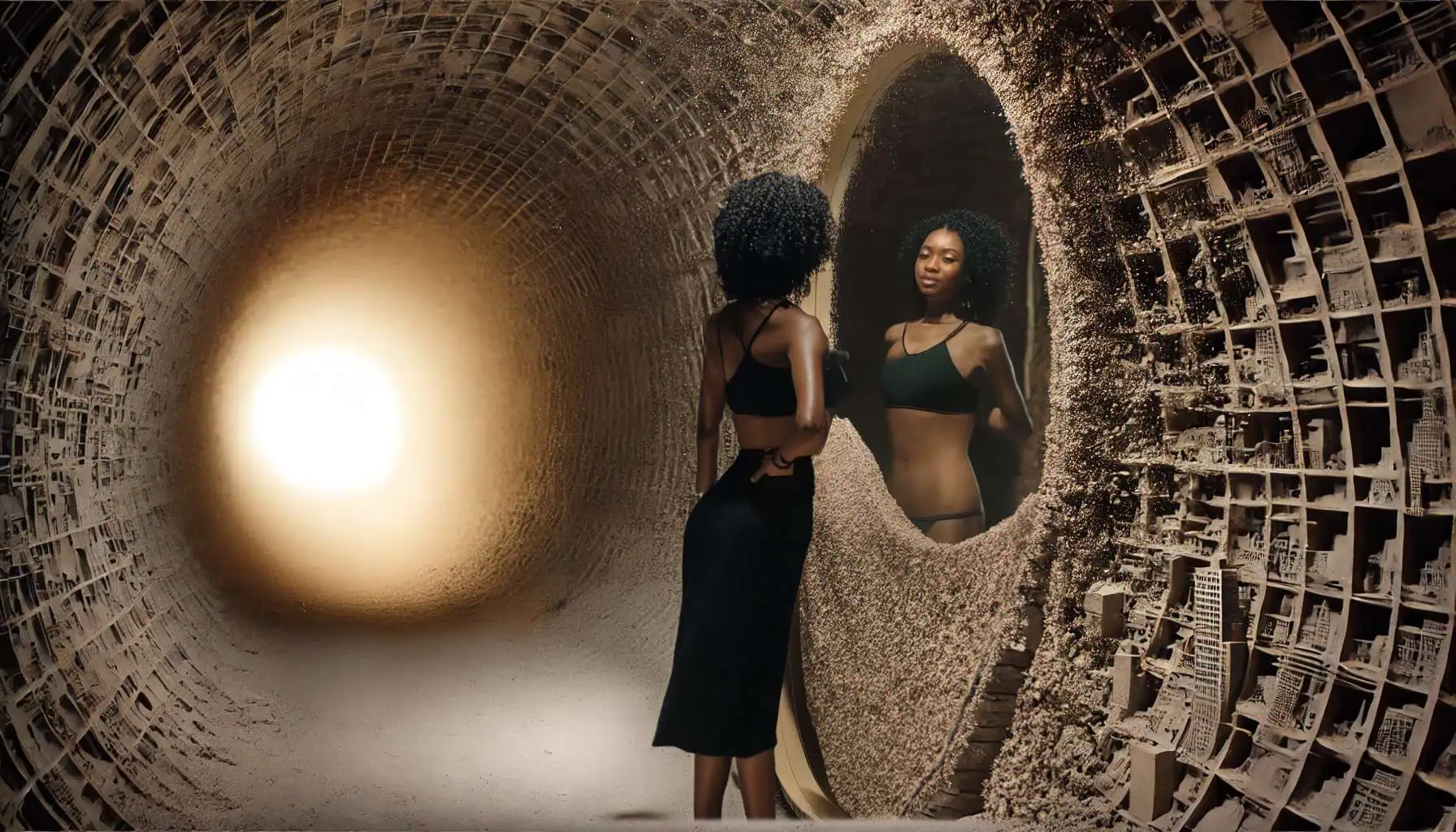
The Allure of Big Butts
In human attraction, few features have captured the collective imagination and appreciation as profoundly as big buttocks. The allure of curvaceous big butts transcends mere aesthetics, delving into a rich tapestry of historical, cultural, biological, and psychological factors and sexual attraction.
From ancient civilizations that revered fuller figures as symbols of fertility and strength to modern cultural movements that celebrate body diversity, the admiration for more prominent buttocks has deep and varied roots.
By understanding the multifaceted reasons behind this appeal, we can gain a more comprehensive appreciation of human beauty and the diverse ways it manifests.
The Cultural Significance of Big Butts

Throughout history, people have viewed large buttocks as symbols of fertility and health. Ancient civilizations in Africa and South America celebrated fuller figures in their art and culture. These societies created sculptures, paintings, and other forms of artistic expression that highlighted and revered fuller bodies, reflecting a deep-seated recognition of the fertility and strength that larger buttocks symbolized. In these cultures, a fuller figure represented vitality, prosperity, and the ability to bear children, which were highly valued attributes. This admiration forms a part of their rich cultural heritage.
Cultural differences significantly shape beauty ideals, which vary widely across the globe. Many African and Latin American cultures have long admired and celebrated voluptuous bodies with larger buttocks. This admiration stems from historical, social, and environmental factors.
For example, some African cultures view more prominent buttocks as a sign of wealth and health, indicating good nutrition and genetic fitness. Similarly, in Latin American cultures, the celebration of curves traces back to indigenous influences and the blending of various cultural traditions over centuries.
Biological and Evolutionary Factors
Evolutionarily, larger buttocks have often been seen as indicators of good health and strong genes. This perception is tied to the body’s ability to store fat in the belly, hips, and buttocks, which can be advantageous for energy storage and childbearing and contribute to genetic fitness.
Fat stored in these areas provides a crucial energy reserve, supporting reproductive processes and sustaining a mother during pregnancy and breastfeeding. Consequently, people with larger buttocks may have historically been perceived as more capable of bearing and nurturing offspring, making this trait desirable from an evolutionary perspective. The waist-to-hip ratio (WHR) also plays an important role in the biological appeal of large buttocks. A lower WHR, which typically features wider hips and larger buttocks relative to a smaller waist, is often associated with attractiveness and health.
Studies consistently show that a WHR of around 0.7 is perceived as the most attractive culture and period. This specific ratio is thought to signal reproductive health and vitality, as it is associated with better hormonal balance, higher fertility, and lower risk of chronic diseases. The preference for a lower WHR underscores the deep-rooted biological cues influencing human attraction and the perception of physical health.
These evolutionary and biological factors provide a foundational understanding of why larger buttocks and longer backs are often considered attractive. They highlight how deeply ingrained these preferences are in human biology, reflecting fundamental health, fertility, and survival.
Impact on beauty standards and self-perception

In recent decades, media and pop culture have played a pivotal role in shaping beauty standards, particularly the admiration for a more prominent figure and larger buttocks. Celebrities and influencers have popularized this body type, bringing it to the forefront of mainstream culture.
Their prominence in media has significantly impacted public perceptions of beauty, making curvier figures more desirable. Social media platforms further amplify these ideals, with countless posts, images, and videos highlighting and celebrating larger buttocks. This constant exposure reinforces the notion that this body type is the epitome of attractiveness, influencing how people view themselves and others.
The rise of the body positivity movement has also had a profound impact on how society perceives different body types, including those with more prominent buttocks. This movement meant accepting and celebrating all body shapes and sizes, challenging the narrow beauty standards perpetuated by the media.
It encourages self-love and body acceptance, promoting the idea that everyone is beautiful in their own way. By highlighting the beauty of diversity, the body positivity movement helps to normalize larger buttocks and other body variations.
This shift in perspective allows individuals to embrace their unique physical attributes without feeling pressured to conform to unrealistic ideals. Through social media campaigns, public figures, and grassroots activism, the body positivity movement fosters a more inclusive understanding of beauty, supporting mental and emotional well-being by validating all forms of self.
The Rise of Butt Augmentation
The growing, more prominent action for larger buttocks has led to a significant rise in cosmetic surgery, particularly butt augmentation. Rising beauty standards favor fuller figures, and the demand for surgical enhancements has surged. Popular procedures like the Brazilian Butt Lift (BBL) and silicone implants have become mainstream.
These procedures often involve the use of injected fat to enhance the buttock area, creating long-lasting results. This reflects the evolving ideals and the powerful influence of media and cultural icons on personal body image. However, the rise of these procedures also brings attention to the risks, costs, and ethical considerations involved, highlighting the challenging and problematic interplay between societal pressures and individual choices.
The popularity of Brazilian butt lifts and others. Plastic surgery procedures

Brazilian Butt Lifts (BBLs) have surged in popularity, with a growing number of women opting for the procedure to achieve fuller, more enhanced buttocks. The BBL involves transferring fat from body areas, such as the abdomen or thighs, to the buttocks, creating a more rounded and lifted appearance to make long-lasting results.
It may require a subsector to shape the area to shape the region further. This procedure is favored for its ability to deliver natural-looking results, contour other body parts, and make it a comprehensive body sculpting solution. The influence of celebrities and social media diet trends has significantly contributed to the rise in BBLs, as many seek to emulate the body proportions showcased by public figures.
In addition to BBLs, other plastic surgery procedures aimed at enhancing the buttocks are also on the rise. Butt implants, which involve the insertion of silicone implants to increase the size and shape of the buttocks, are becoming more common. Fat transfer procedures are also gaining traction, similar to BBLs but often used for smaller adjustments. These options provide a range of choices for individuals looking to enhance their buttocks, catering to patients across ages and with different preferences and aesthetic goals.
Benefits and risks of butt augmentation
The benefits of butt augmentation are manifold, particularly in the context of body contouring. A primary advantage is achieving a more rounded and feminine aesthetic, which can enhance the overall body silhouette. Many individuals report a significant boost in self-confidence following the procedure, feeling more comfortable and satisfied with their appearance. The ability to reshape and balance improves positive psychological effects, self-esteem, and body image.
However, butt procedures are not without risks. Potential complications include infection, scarring, and the risk of fat embolism, particularly in patients with BBLs. Fat embolism occurs when fat enters the bloodstream and causes blockages, which can be life-threatening.
Additionally, there is the potential for unrealistic expectations, where some may seek unrealistically or cost-sustainable results. This can lead to dissatisfaction with the outcome and the desire for further procedures, which carry their risks. It is crucial for individuals considering butt enlargement to have a thorough understanding of the benefits and risks and to have realistic expectations, ensuring they make informed decisions about their
The Anatomy of a Big Butt

The anatomy of a big butt involves a complex interplay of gluteal muscles and fat distribution. The gluteal muscles, consisting of the gluteus maximus, gluteus medius, and gluteus minimus, play a crucial role in the shape and function of the buttocks. The gluteus maximus is the largest muscle, providing the bulk of the buttocks’ shape and power. The fat distribution also significantly influences the size and shape of the buttocks, with genetic and hormonal factors determining how and where fat is stored in the body.
Understanding this anatomy is essential for appreciating the aesthetic appeal of larger buttocks. The prominence of the gluteal muscles and the distribution of fat contribute to a rounded and lifted appearance, which is often considered attractive. The buttocks’ symmetry and proportionality further enhance this aesthetic appeal with the rest of the body.
Larger buttocks play a vital role functionally in various physical activities. The gluteal muscles are responsible for hip extension, abduction, and rotation, essential for walking, running, and climbing. Strong gluteal muscles contribute to overall stability and balance, reducing the risk of injury and enhancing athletic performance.
The butt cheek shapes the ideal physique and often serves as a hallmark of attractiveness and physical fitness. Many cultures consider a larger, more rounded cheek desirable, contributing to the body’s overall aesthetic appeal. The prominence and curvature of the butt cheeks enhance body proportions, creating a balanced and harmonious silhouette that many strive to achieve.
Thus, this suggests the butt cheek’s role in shaping the ideal physique is multifaceted, involving both muscular development and fat distribution. This combination affects appearance, physical performance, and stability, underscoring the importance of the gluteal region.
The Psychology of Attraction
The psychology of attraction delves into why certain physical traits are attractive, how media sexualization shapes these perceptions, and their impact on human behavior and social interactions. The allure of big buttocks, in particular, has garnered significant attention.
This fascination can be traced back to evolutionary, cultural, and social factors that shape our perceptions of beauty and desirability. However, the psychological impact of these preferences also has more profound implications, particularly concerning the objectification and portrayal of women with prominent buttocks in media and society.
Objectification and the portrayal of women with big butts

The fetishization and sexualization of big butts often lead to the objectification of women’s bodies, reducing them to their physical attributes. This cultural phenomenon places undue emphasis on specific body parts, diminishing the recognition of women as individuals with diverse qualities and capabilities. Such focus on physical characteristics can contribute to a narrow and unrealistic standard of beauty, which in turn affects women’s self-esteem and body image.
Furthermore, the pervasive sexualization perpetuates harmful stereotypes and reinforces gender inequality. It often results in women being valued primarily for their physical appearance rather than their intellectual, emotional, or professional contributions. This objectification can lead to societal pressures for women to conform to these ideals, often through unhealthy means such as extreme dieting or cosmetic surgery.
The media plays a significant role in propagating these standards through music, television, movies, and social media, where images of women with exaggerated body features are frequently glamorized. This representation influences public perception and can harm how women view themselves and how others treat them.
Addressing the issue requires a cultural shift towards recognizing and valuing women for their full humanity, including their talents, achievements, and inner qualities. Promoting body positivity and diverse representations in media can help combat the fetishization and sexualization of women’s bodies, fostering a more inclusive and respectful society.
Misogyny, racism, and cultural appropriation in the pursuit of big butts
The obsession with big butts and thighs can perpetuate misogyny, racism, and cultural appropriation, particularly affecting women of color. Historically, women of African and Latin American descent have been celebrated for their curvier figures.
However, it can lead to cultural appropriation when those outside these cultures adopt and popularize these physical traits without acknowledging their origins and meaning. This erasure of cultural significance ignores the historical and social contexts that have shaped these beauty ideals.
Additionally, the pursuit of big butts often involves stereotypes that can be harmful. For example, women of color may face hypersexualization and objectification based on their body and skin type, reinforcing racial stereotypes and contributing to a lack of respect and understanding of their cultural heritage. These racial issues intersect with misogyny, reducing women to mere objects of sexual desire and undermining their autonomy and humanity.
Conclusion
The appeal of big butts has led to a multibillion-dollar industry of beauty products and plastic surgery procedures, reflecting a widespread desire to achieve this specific aesthetic. This trend has significant implications, particularly for women of color, who often find their bodies commodified and fetishized.
While the popularity of larger buttocks highlights evolving beauty standards, it also perpetuates harmful stereotypes and unrealistic expectations. These ideals can pressure individuals to conform to a narrowly defined notion of attractiveness, often at the expense of their health and well-being. Moreover, focusing on a single body part reduces individuals to their physical appearance, overshadowing their talents, personality, and contributions.
Understanding this trend’s psychological, cultural, and social dynamics is crucial. It can help foster a more inclusive and respectful appreciation of diverse body types, moving beyond superficial standards to celebrate the whole person. Promoting body positivity and diversity can help society dismantle the harmful stereotypes associated with beauty.
This shift can encourage self-acceptance and respect for all body shapes and sizes, leading to a healthier and more inclusive view of beauty.
In conclusion, the allure of big butts has positively influenced modern beauty standards and driven a lucrative industry. Recognizing the broader implications of this trend is essential. We can move towards a more inclusive and respectful society by embracing a holistic understanding of beauty that values diversity and individuality. This shift allows us to celebrate all body types and appreciate the unique beauty each person brings.
FAQ
Why do people find big butts attractive?
Evolutionary, biological, and cultural factors all influence the attraction to big butts. Evolutionarily, people see larger buttocks as a sign of fertility and good health. Culturally, media and societal trends have popularized this body type, making it a desirable trait.
What is the role of the gluteus maximus in shaping the hips and buttocks?
The gluteus maximus is the most significant muscle in the human body and is primarily responsible for the shape and size of the buttocks. Along with other parts of the gluteus medius and minimus, it helps provide a rounded and lifted appearance, contributing to the overall aesthetic and functional aspects of the person and buttocks.
How have media and pop culture influenced the popularity of big butts?
Media and pop culture have significantly influenced beauty standards by frequently showcasing celebrities and influencers with larger buttocks. Reality and Pop Stars have popularized this body type, and social media platforms amplify these ideals, shaping public perceptions of beauty.
What are the benefits of butt augmentation procedures like BBLs?
Benefits of butt augmentation surgery include achieving a more rounded and feminine aesthetic and a boost in self-confidence. Procedures like BBLs allow for natural-looking enhancements by transferring fat from other body areas to the buttocks, which also helps contour different body parts.
What risks do butt augmentation procedures carry?
Risks of butt augmentation procedures include infection, scarring, and fat embolism, particularly with BBLs. The severe cost and potential for unrealistic expectations can lead to dissatisfaction with the results and additional procedures over time.
How does the fetishization of big butts impact women?
The fetishization of big butts can lead to the sexualization of women’s bodies, reducing them to their physical appearance. This can result in harmful stereotypes, objectification, and unrealistic beauty standards, negatively affecting women’s self-esteem and mental health.
What is the impact of cultural appropriation in the context of big butts?
Cultural appropriation happens when people adopt traits from specific cultures, such as larger buttocks from Latin American and African cultures, without acknowledging their origins. This can lead to the erasure of cultural significance and perpetuate stereotypes, marginalizing those who originally celebrated these traits.
How does the body positivity movement address the issue of big butts?
The body positivity movement encourages celebrating all body types, including those with larger buttocks. It promotes self-love and acceptance, challenging narrow beauty standards and helping to normalize diverse body shapes. This movement supports mental and emotional well-being by validating individual differences.
What is the “dark side” of the obsession with big butts?
The dark side includes misogyny, racism, and the exploitation of women with big butts. The pursuit of this body type can reinforce harmful stereotypes, lead to objectification, and contribute to unrealistic beauty standards. It also raises ethical concerns about cultural appropriation and the pressures on women to undergo risky procedures.
What should individuals consider before undergoing butt augmentation procedures?
Individuals should thoroughly understand the benefits and risks, have realistic expectations, and seek qualified medical professionals. It’s essential for patients to remember to prioritize health and well-being over conforming to beauty standards, ensuring informed decisions about one’s body.

